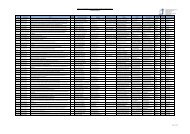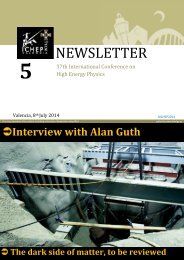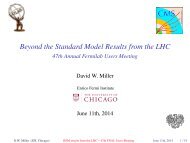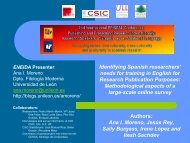PW_mar13_sample_issue
PW_mar13_sample_issue
PW_mar13_sample_issue
Create successful ePaper yourself
Turn your PDF publications into a flip-book with our unique Google optimized e-Paper software.
Quantum frontiers: Communication in space<br />
52<br />
physicsworld.com<br />
The quantum space race<br />
Sending satellites equipped with quantum technologies into space will be the first step towards a<br />
global quantum-communication network. As Thomas Jennewein and Brendon Higgins explain, these<br />
systems will also enable physicists to test fundamental physics in new regimes<br />
Thomas Jennewein<br />
and Brendon<br />
Higgins are at the<br />
Institute for<br />
Quantum Computing<br />
at the University of<br />
Waterloo, Canada,<br />
e-mail thomas.<br />
jennewein@<br />
uwaterloo.ca<br />
Suppose you have a photon – a single particle of<br />
light. This is a quantum system by nature, so it<br />
exists in a particular quantum state. The photon<br />
could, for example, be vertically polarized, horizontally<br />
polarized or even something in-between: a<br />
quantum superposition.<br />
So what happens when you send your photon to<br />
a receiver at some other location? This question<br />
sounds simple but the answer can tell us some quite<br />
fundamental and startling truths about nature. In<br />
fact, when a pair of photons possesses correlations<br />
much stronger than classically allowed – entangled<br />
quantum states – the implications of what we observe<br />
in so-called “Bell tests” are enough to have spooked<br />
even Albert Einstein, and many people thereafter.<br />
The consequences of these experimental and theoretical<br />
insights are profound as they conflict with<br />
our intuitive understanding of how the world works<br />
(see box on p54). As Richard Feynman wryly concluded:<br />
“after people read [Einstein’s paper on relativity],<br />
a lot of people understood [it] in some way or<br />
other, certainly more than 12. On the other hand,<br />
I think I can safely say that nobody understands<br />
quantum mechanics”.<br />
Beyond these fundamental interests is the field of<br />
quantum communication – the science of transmitting<br />
quantum states from one place to another. Information<br />
is often transmitted by using the aforementioned<br />
vertically polarized light to represent the “0”, horizontally<br />
polarized to represent the “1” and a quantum<br />
superposition to represent a combination of “0”<br />
and “1” simultaneously. Quantum communication<br />
has received significant attention in the last few years<br />
owing to the discovery of quantum cryptography.<br />
Quantum-assured security<br />
Quantum cryptography, or, more correctly, quantum<br />
key distribution (QKD), exploits the fundamental<br />
nature of quantum systems to change state<br />
upon measurement, allowing you to establish a common<br />
encryption key between yourself and a distant<br />
partner with the absolute certainty that if someone<br />
is eavesdropping, you will know about it. An eavesdropper<br />
would leave a trace and, if none is found, the<br />
key can be safely used to securely encode messages.<br />
These messages are sent using ordinary, classical<br />
communication channels, before being decoded by<br />
the distant party using their copy of the key. Traditional<br />
encryption techniques, in contrast, either rely<br />
on assumptions that certain mathematical operations<br />
are difficult to invert, or require the effort of a<br />
trusted courier to physically carry the key from one<br />
location to the other.<br />
Because of this obvious and significant application,<br />
it is not just researchers tucked away in university<br />
laboratories who are interested. Several<br />
quantum-communication companies have also<br />
emerged over the last few years seeking to exploit<br />
the secure messaging that QKD allows, including<br />
ID Quantique in Switzerland, MagiQ in the US and<br />
QuintessenceLabs in Australia. Their efforts come<br />
on top of established programmes by the likes of HP,<br />
IBM, Mitsubishi, NEC, NTT and Toshiba. All of<br />
these companies – and more – are looking to develop<br />
real-world-applicable QKD devices for governments,<br />
banks and other security-focused clients.<br />
The devices that are being built and implemented<br />
today form the seeds of what could one day become<br />
a grander quantum internet – interconnected networks<br />
of quantum-communication channels. These<br />
networks would permit not just quantum-secured<br />
communications, but also distributed quantum computation<br />
(several quantum computers working on<br />
the same problem in tandem) and other quantumenhanced<br />
information technologies.<br />
While the possibilities are exciting, quantum communication<br />
over long distances turns out to be really<br />
difficult. The culprit: transmission loss. Signals<br />
weaken in intensity when they travel long distances<br />
because photons get absorbed or scatter off molecules,<br />
with the transmission loss getting exponentially<br />
worse with distance. Classical communication<br />
can cope with the high losses experienced over long<br />
distances by using repeater devices to boost the signal.<br />
But for quantum signals this approach does not<br />
work. Quantum signals cannot be perfectly cloned,<br />
which rules out standard repeaters, and tricks such as<br />
boosting the signals by transmitting many duplicates<br />
of each quantum state at the same time would defeat<br />
the purpose of encoding information into individual<br />
quantum systems in the first place: an eavesdropper<br />
could simply pick off and examine a subset of<br />
those duplicates, which outwardly would appear to<br />
be nothing more than regular loss. As it stands, the<br />
furthest that quantum-communication signals have<br />
been sent is only a few hundred kilometres.<br />
For applications such as quantum cryptography,<br />
that distance restriction means that your QKD system<br />
can at best allow you to securely communicate<br />
with someone just one or two cities away, which is<br />
hardly ideal in an increasingly globalized society.<br />
Moreover, in terms of physics research, it means that<br />
Physics World March 2013








